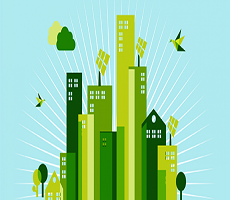 The debate about the economic, commercial and social benefits of green building design continues to evolve rapidly. Where once it was primarily focussed on environmental issues and related cost savings, the world’s major champions of eco-building are now making the case for sophisticated building design that has a broader range of benefits for organisations and individuals. The most significant report in this regard for some years has just been published by the World Green Building Council (WorldGBC). Its study Health, Wellbeing and Productivity in Offices: The Next Chapter for Green Building offers “overwhelming evidence” for the ways in which office design significantly impacts the health, happiness, wellbeing and productivity of people.The report covers a wide range of that influence the wellness, job satisfaction and performance of office workers. It identifies the ways in which these undoubted benefits add a new layer of sophistication to the case for organisations to invest in better, healthier and greener buildings.
The debate about the economic, commercial and social benefits of green building design continues to evolve rapidly. Where once it was primarily focussed on environmental issues and related cost savings, the world’s major champions of eco-building are now making the case for sophisticated building design that has a broader range of benefits for organisations and individuals. The most significant report in this regard for some years has just been published by the World Green Building Council (WorldGBC). Its study Health, Wellbeing and Productivity in Offices: The Next Chapter for Green Building offers “overwhelming evidence” for the ways in which office design significantly impacts the health, happiness, wellbeing and productivity of people.The report covers a wide range of that influence the wellness, job satisfaction and performance of office workers. It identifies the ways in which these undoubted benefits add a new layer of sophistication to the case for organisations to invest in better, healthier and greener buildings.
It argues that, with salaries and benefits typically responsible for 90 percent of an organisation’s expenditure, any higher construction or occupation costs are far outweighed by even small improvements in staff performance.The key findings of the report include:
- Indoor air quality: A comprehensive body of research suggests that better indoor air quality (low concentrations of CO2 and pollutants and high ventilation rates) can lead to productivity improvements of 8-11percent.
- Thermal comfort: Research demonstrates that thermal comfort has a significant impact on workplace satisfaction and modest degrees of personal control over thermal comfort can return single digit improvements in productivity.
- Lighting and views of nature: Several studies have estimated productivity gains as a result of proximity to windows, with experts now thinking that views from windows are probably the more significant factor, particularly where the view offers a connection to nature.
- Noise and acoustics: Research suggests that being productive in the modern knowledge-based office is practically impossible when noise provides an unwanted distraction. This can be a major cause of dissatisfaction amongst occupants.
- Interior layout: The way the interior of an office is configured (including workstation density and configuration of work space, breakout space and social space) has been found to have an impact on concentration, collaboration, confidentiality and creativity.
- Active design and exercise: Health can be improved through exercise, and so active design within a building, and access to services and amenities such as gyms, bicycle storage and green space can help to encourage healthier lifestyles of building occupants.
The report is ahead of the curve in many ways but many companies are already investing significantly in green building design. A recent report from CBRE and Maastricht University based on data from the US Green Building Council found that, over the past decade, there has been a transformation in the way occupiers and the commercial property market in the US approaches the environmental design of buildings. According to their National Green Building Adoption Index for 2014 there has been a remarkable increase in the use of green building standards in the thirty most important regional commercial property markets in the US. Based on data from the US Green Building Council, the number of office buildings which are LEED or Energy Star certified has surged since 2005. The proportion of LEED certified buildings in America now stands at 5 percent, up from under 0.5 percent over the course of the survey period. The total proportion of office space which now has some form of green accreditation is now just under a fifth.
Many of these buildings will have been commissioned and constructed based on the ethical standards and desire to keep down energy costs of their potential occupiers. Now that the business case for green building is increasingly focussed on improving the wellness and productivity of the people who work in them, we might expect a new surge of interest in the design of environmentally friendly buildings.
__________________________________________
 Alison Kitchingman is Director of Marketing and Design at Milliken – Carpet Division. www.millikencarpet.com
Alison Kitchingman is Director of Marketing and Design at Milliken – Carpet Division. www.millikencarpet.com














October 29, 2014
The business case for green building widens to cover wellness and productivity
by Alison Kitchingman • Comment, Environment, Facilities management, Workplace design
It argues that, with salaries and benefits typically responsible for 90 percent of an organisation’s expenditure, any higher construction or occupation costs are far outweighed by even small improvements in staff performance.The key findings of the report include:
The report is ahead of the curve in many ways but many companies are already investing significantly in green building design. A recent report from CBRE and Maastricht University based on data from the US Green Building Council found that, over the past decade, there has been a transformation in the way occupiers and the commercial property market in the US approaches the environmental design of buildings. According to their National Green Building Adoption Index for 2014 there has been a remarkable increase in the use of green building standards in the thirty most important regional commercial property markets in the US. Based on data from the US Green Building Council, the number of office buildings which are LEED or Energy Star certified has surged since 2005. The proportion of LEED certified buildings in America now stands at 5 percent, up from under 0.5 percent over the course of the survey period. The total proportion of office space which now has some form of green accreditation is now just under a fifth.
Many of these buildings will have been commissioned and constructed based on the ethical standards and desire to keep down energy costs of their potential occupiers. Now that the business case for green building is increasingly focussed on improving the wellness and productivity of the people who work in them, we might expect a new surge of interest in the design of environmentally friendly buildings.
__________________________________________